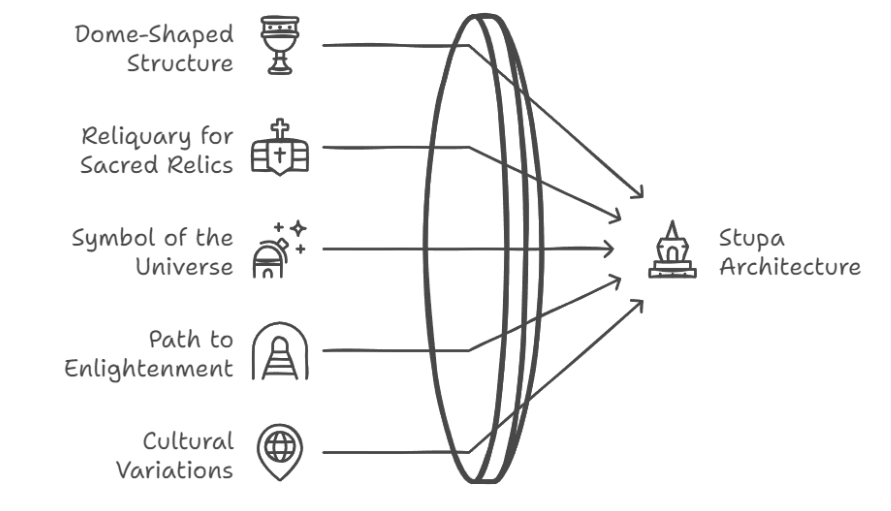-
Q. "The stupa architecture of ancient India reflects not just religious beliefs but also the political and social dynamics of its time." Discuss with special reference to the stupas of Sanchi. (150 words)
21 Oct, 2024 GS Paper 1 Indian Heritage & CultureApproach
- Introduce the answer by mentioning the significance of Stupa Architecture
- Give its role in understanding Religious, Political, and Social Dynamics of Ancient India
- Conclude suitably.
Introduction
The stupa architecture of ancient India serves as a profound testament to the religious, political, and social landscape of its time. These monumental structures, particularly exemplified by the stupas of Sanchi, offer valuable insights into the complex interplay between Buddhist theology, royal patronage, and societal norms.
Body
Stupas- Window into Ancient India's Religious, Political, and Social Dynamics:
- Religious Significance: Its development reflects the evolution of Buddhist practices and beliefs:
- Aniconic Representation: The earliest art at Sanchi, dating to the Mauryan period, represents Buddha through symbols rather than human form.
- This reflects early Buddhist reluctance to depict the Buddha figuratively.
- Jataka Tales: The gateways (toranas) are adorned with scenes from Buddha's life and Jataka tales, illustrating the growing importance of narrative traditions in Buddhism.
- Relics: Stupa 3 at Sanchi contained relics of Sariputra and Maudgalyayana, chief disciples of Buddha.
- This highlights the importance of relic worship in early Buddhism.
- Aniconic Representation: The earliest art at Sanchi, dating to the Mauryan period, represents Buddha through symbols rather than human form.
- Political Dynamics: The development of Sanchi over centuries reflects changing political landscapes:
- Mauryan Patronage: Emperor Ashoka's establishment of the site in the 3rd century BCE demonstrates the Mauryan empire's role in spreading Buddhism.
- The Ashoka pillar at Sanchi symbolizes imperial power aligned with Buddhist values.
- Sunga Expansion: The enlargement of Stupa 1 during the Sunga dynasty (2nd-1st century BCE) shows continued royal patronage despite the Sungas' reputation for favoring Brahmanism.
- Satavahana Contributions: The ornate gateways added during the Satavahana period (1st century CE) reflect the expanding wealth and artistic sophistication of this dynasty.
- Mauryan Patronage: Emperor Ashoka's establishment of the site in the 3rd century BCE demonstrates the Mauryan empire's role in spreading Buddhism.
- Social Dynamics: The art and architecture at Sanchi provide insights into ancient Indian society:
- Inscriptions at Sanchi reveal donations from various social groups, including monks, nuns, laypeople, and guilds. This reflects the broad social base of Buddhism and the participatory nature of stupa construction.
- The reliefs on the gateways depict scenes of city life, showing the growing urbanization of ancient India and Buddhism's appeal to urban populations.
- The presence of non-local artistic influences (such as Achaemenid-inspired lion capitals) suggests Sanchi's connection to wider trade networks.
Conclusion
The stupa architecture of ancient India, particularly exemplified by the Sanchi complex, stands as a multifaceted cultural artifact. It not only embodies core Buddhist principles but also reflects the political aspirations of rulers, the social dynamics of communities, and the artistic and technological achievements of the time.
To get PDF version, Please click on "Print PDF" button.
Print PDF





